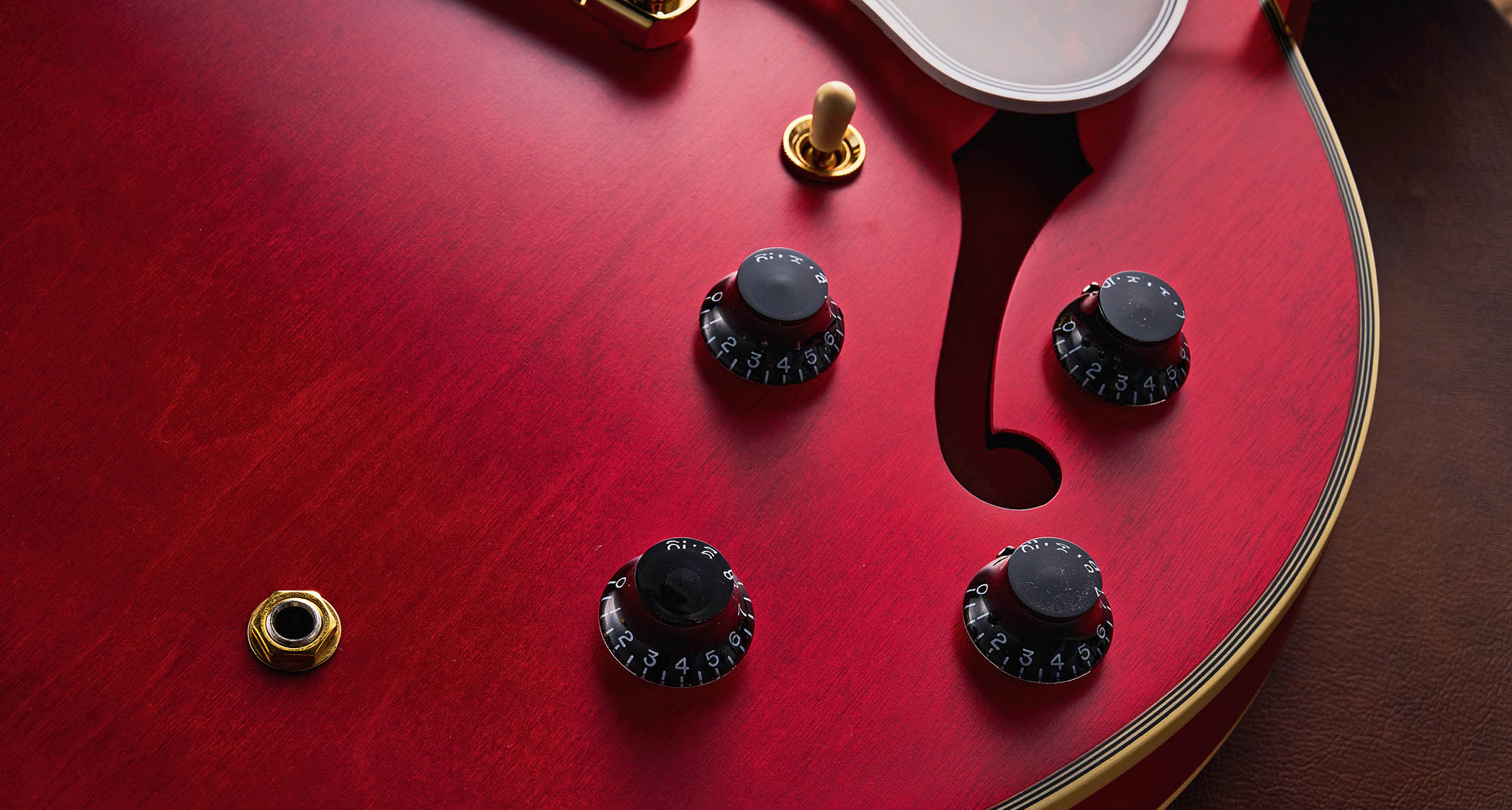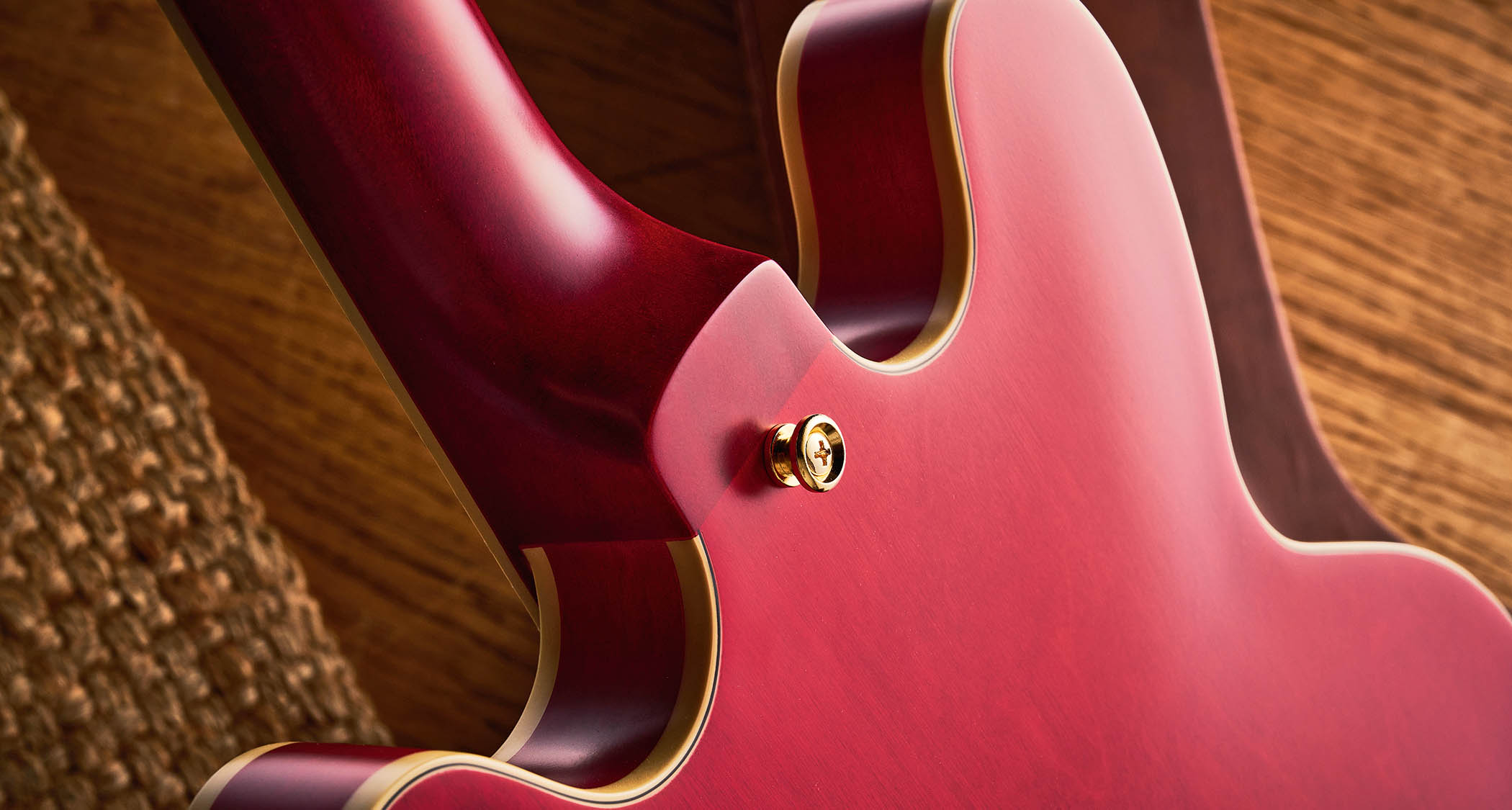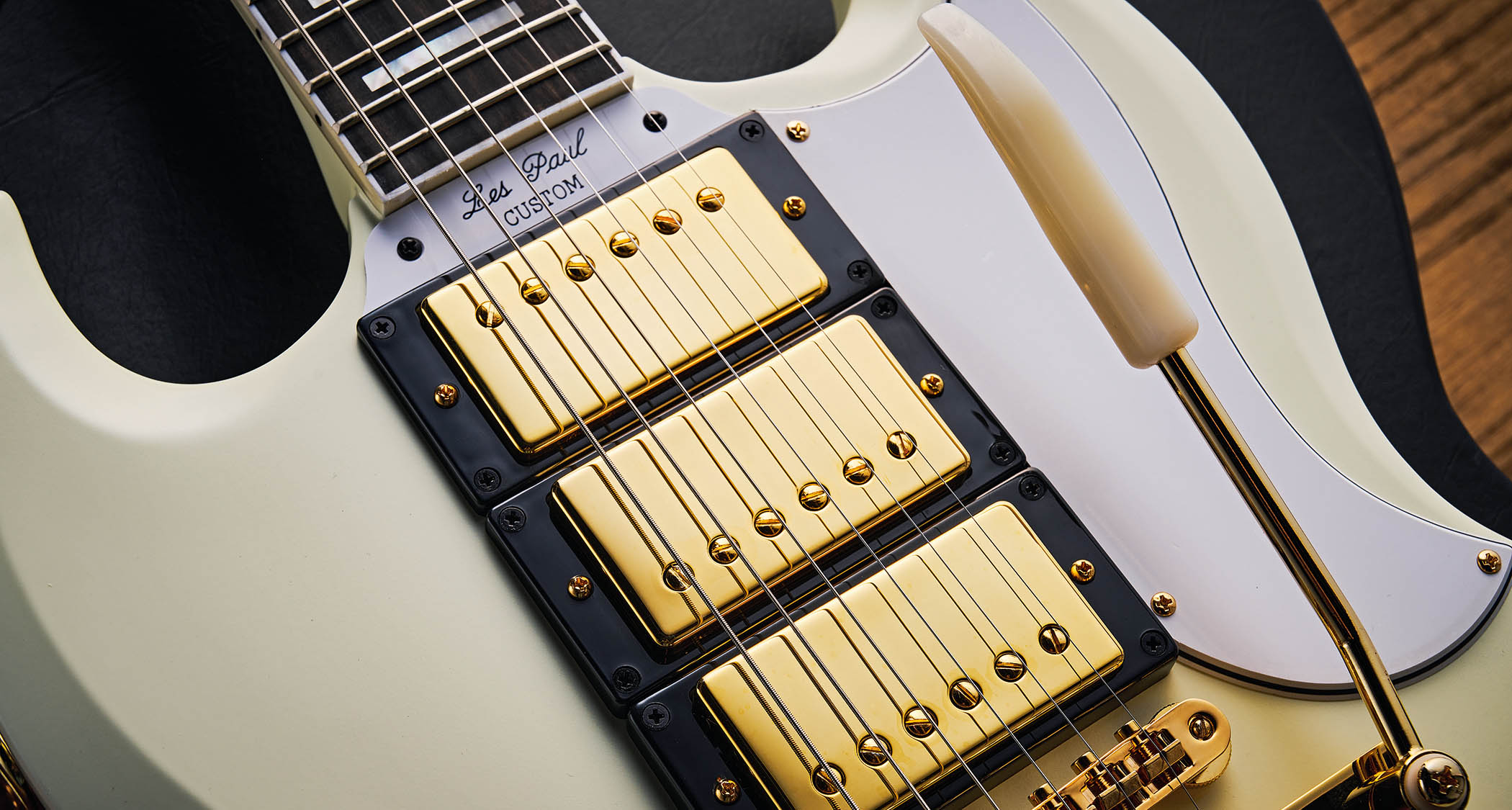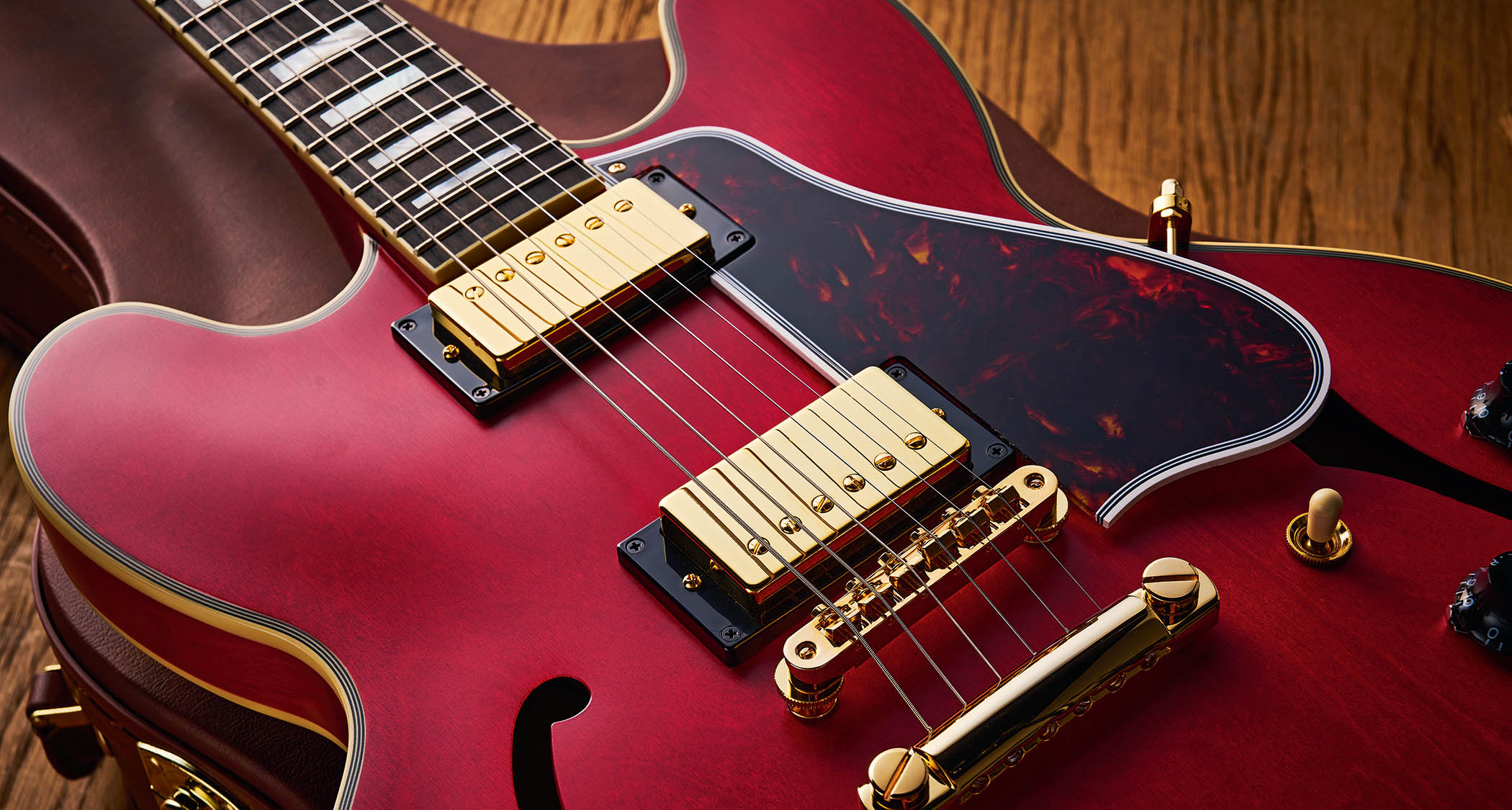Guitar World Verdict
While the niggles we’ve uncovered will surely be ironed out as production progresses, they did take us a little by surprise. However, behind this lie two guitars that are immensely rewarding to play, with characters that shine through both visually and from a sound perspective.
Pros
- +
SG Custom is almost unmatched visually.
- +
Fabulous if not infinite range of beefy tones.
- +
Real ebony ’board and top-quality electrics.
- +
ES-335 is a looker, too.
- +
Stunning range of dynamically potent tones.
- +
Excellent value for money.
- +
Top-class pickups, hardware and general materials.
Cons
- -
It’s a shame about the noticeable ridge on SG's neck binding.
- -
We would have preferred full gloss finish.
- -
ES-335's wonky heel also came as a surprise (and is surely something of an aberration?)
You can trust Guitar World
When it comes to impressive-looking guitars, it’s hard to imagine anything more sensational looking (save perhaps for Gretsch’s White Falcon) than a three-pickup, white Gibson SG Custom with Vibrola, and a Cherry Red ES-355.
When released, both instruments sat at the top of their respective family trees and boasted pretty much every flashy element that Gibson had at its disposal. Thus it was ebony rather than rosewood fingerboards, gold instead of nickel plating, and real mother-of-pearl over the swirly celluloid found on SG Standard and ES-335 models.
In the SG’s case, it also added a third pickup and when finished in white and with a big gold vibrato (did they pinch the idea from Gretsch?) looked spectacular. In line with its recent collaborations with the Gibson Custom Shop, Epiphone has released its own take on these illustrious models. So let’s dive in…
As you’d imagine, these guitars are as close as possible to the original spec, given today’s production methods, availability of materials and so on.

Hence in the SG’s case we see a centre-joined spread of mahogany for the body (not a single slab as on the originals), a one-piece long-tenon mahogany neck that joins at the 22nd fret, and a single-bound ebony fingerboard with real mother-of-pearl block markers. The headstock bears the striking ‘split H’ inlay of all Les Paul Customs and features the usual multiple edge binding.
In the ES-355’s case, it’s a laminated maple and poplar body with solid spruce centre block, and again a one-piece mahogany neck (20th-fret join this time), plus bound ebony ’board. At first we thought Epiphone had chosen pearloid for the 355’s inlays, as it looked less reflective. However, further investigation revealed it to be the real thing.

One thing that is a little bemusing about this pair is Epiphone’s choice of VOS polyurethane finish. VOS stands for ‘vintage original sheen’, but vintage guitars don’t go matt in this way, neither were they satin lacquered at creation. So we’d have preferred the no-nonsense gloss.
All the latest guitar news, interviews, lessons, reviews, deals and more, direct to your inbox!
The SG goes full bling with its huge gold, Epiphone-stamped Maestro Vibrola
While in critical mode (and that’s very unusual for Epiphones these days), the ES-355’s heel is lopsided, the left corner being nicely rounded but the right definitely more pointed. We’ve looked online and the heels on all the other guitars have been correct, in other words symmetrical. Clearly, this is an aberration, but not one we expect from the Qingdao facility.
On a much more positive note, pickups, hardware and innards are all first grade, with triple Gibson USA Custombucker pickups on the SG, a pair of the same on the ES-355, Grover 18:1 ‘kidney bean’ Rotomatic tuners on both, with CTS pots, Mallory capacitors and Switchcraft jacks all round.
Both instruments carry 22 medium jumbo frets and Graph Tech nuts, and while the ES-355 has the expected ABR-1-style tune-o-matic bridge with aluminium stud tailpiece, the SG goes full bling with its huge gold, Epiphone-stamped Maestro Vibrola.
Feel & Sounds

There’s another criticism we have to level, this time only at the SG. On any guitar where the colour is sprayed all over then scraped away from binding and so on, or even previously masked up, a ridge is inevitably formed.
This is usually filled in by multiple coats of clear lacquer then sanded flush. It’s a common criticism on Gibsons where nitrocellulose shrinks back to reveal this ridge. But here on the Epiphone SG Custom’s neck it’s pretty prominent and really shouldn’t be given that these are finished in polyurethane.
The temptation is to gently sand it back with ultra-fine wet-or-dry paper, but the danger is always to sand through (so don’t try it, folks!), and on satin finishes it’s all but impossible to exactly replicate the factory sheen.

Other than that it’s positivity all the way. Although Epiphone describes it as ‘SlimTaper’, our SG Custom’s neck is a healthy handful and the action, although not overly low, suits the 305mm (12-inch) fingerboard radius and medium jumbo frets well.
Fretboard access is total, and while you do have to get used to everything about a three-humbucker SG with a big vibrato system, a little rejigging of your playing position soon reveals a guitar that’s great fun to play (especially standing up, looking in a mirror!). The Vibrola happily handles gentle wobbles or even quite manic wanging without question.
Moving onto the ES-355, its medium rounded 50s neck profile is again a friendly place to be. We felt instantly at home, and while those top frets aren’t quite so available, it’s no struggle to play shape 1 A minor pentatonic at the 17th fret. Everything that applies to the SG does here, too, except that standing up to play is a far more familiar experience.
Sonically, while both instruments bear Gibson’s brilliant Custombuckers, their size, weight and construction reveal markedly different voices. Where the SG is a straight-down-the-line grunt machine, the ES-355 offers a tad more subtlety. While the solidbody is dark, the thinline is lighter, with noticeably more treble on hand. Not to say it won’t spit fire when required.

Both clean up superbly in their slightly different ways, and each responds superbly to the gain channel of our Laney Lionheart 20. Again, the SG packs the less subtle punch, and the ES-355’s charms respond to tone, pickup selection and volume settings to reveal a brilliantly usable set of tones.
A note about the SG’s centre toggle switch position. While the resulting sound of bridge and middle pickup together is sometimes incorrectly described as ‘out of phase’, in fact it’s merely the proximity of one ’bucker to the other that supplies the slightly nasal tone. Both necks will respond to personal playing preferences with a tweak here and there so either of these would make a super playing companion, depending on your taste and style.
Verdict
It’s extremely rare these days that we take Epiphone to task over build quality or attention to detail. And while the niggles we’ve uncovered will surely be ironed out as production progresses, they did take us a little by surprise.

However, behind this lie two guitars that are immensely rewarding to play, with characters that shine through both visually and from a sound perspective. And while we’re not keen on the VOS finish, nevertheless these instruments still make an incredibly bold visual statement.
Plus their use of the highest quality pickups and wiring means they deliver proper, grown-up tones that wouldn’t disappoint even the most critical ear. And look at those SRPs: that’s a ton of guitar (niggles notwithstanding) for the price.
Specs
Epiphone Inspired by Gibson Custom 1963 Les Paul SG Custom

- PRICE: $1,499/£1,379 (inc case)
- ORIGIN: China
- TYPE: Double-cutaway, solidbody electric
- BODY: 2-piece mahogany with chamfered edges
- NECK: 1-piece slim-taper mahogany
- SCALE LENGTH: 629mm (24.75”)
- NUT/WIDTH: Graph Tech/43mm
- FINGERBOARD: Single-bound ebony, mother-of-pearl block inlays, 305mm (12”) radius
- FRETS: 22, medium jumbo
- HARDWARE: Epiphone tune-o-matic bridge and Epiphone branded Maestro Vibrola vibrato/tailpiece, Grover Rotomatic ‘kidney bean’ tuners, gold finish
- STRING SPACING, BRIDGE: 51.5mm
- ELECTRICS: 3x Gibson Custombuckers, 3-way toggle pickup selector switch (centre position bridge and middle pickups together), 2x volume and tone controls
- WEIGHT (kg/lb): 3.8/8.7
- OPTIONS: None
- RANGE OPTIONS: None
- LEFT-HANDERS: No
- FINISHES: Classic White
Epiphone Inspired by Gibson Custom 1959 ES-355

- PRICE: $1,299/£1,199 (inc case)
- ORIGIN: China
- TYPE: Double-cutaway, thinline semi-solid electric
- BODY: Maple and poplar laminate with solid spruce centre block
- NECK: 1-piece slim-taper mahogany
- SCALE LENGTH: 629mm (24.75”)
- NUT/WIDTH: Graph Tech/43mm
- FINGERBOARD: Single-bound ebony, mother-of-pearl block inlays, 304.8mm (12”) radius
- FRETS: 22, medium jumbo
- HARDWARE: Gibson tune-o-matic bridge, aluminium stud tailpiece, Grover Rotomatic ‘kidney bean’ tuners, gold
- STRING SPACING, BRIDGE: 51.5mm
- ELECTRICS: 2x Gibson Custombuckers, 3-way toggle pickup selector switch, volume and tone for each pickup (no Varitone control)
- WEIGHT (kg/lb): 3.8/8.6
- OPTIONS: None
- RANGE OPTIONS: None
- LEFT-HANDERS: No
- FINISHES: Cherry (as reviewed), Classic White, Ebony VOS
- CONTACT: Epiphone
In the late '70s and early '80s Neville worked for Selmer/Norlin as one of Gibson's UK guitar repairers, before joining CBS/Fender in the same role. He then moved to the fledgling Guitarist magazine as staff writer, rising to editor in 1986. He remained editor for 14 years before launching and editing Guitar Techniques magazine. Although now semi-retired he still works for both magazines. Neville has been a member of Marty Wilde's 'Wildcats' since 1983, and recorded his own album, The Blues Headlines, in 2019.


